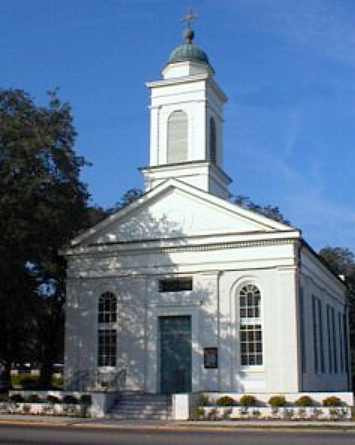 |
| St John - 1917 |
Nearly 100 years passed between the two photos. The words over the arch are "The Lord Is in His Holy Temple". The plaque holding the hymn numbers situated on the arch seems to be the same, painted white from black or a dark color, and moved to the left on the wall. Our best guess is the old picture shows a reed organ on the left in the front of the church.
 |
| St John - 2014 |
When the Victorian decorations around the archway and windows were painted over, I can't say, but by 1969, when we moved to Thibodaux, the decorations were gone. And all to the good, in my opinion, in our beautiful Greek Revival style church.
St. John's Episcopal Church is locally important because it is the oldest remaining church building of the Episcopal Diocese of Louisiana west of the Mississippi River. The square on which it is located has been the home of the church parish since it was organized by Bishop Leonidas K. Polk on February 9, 1843. Even though the building underwent some alterations in 1856 and again in 1867-68, it is still a good example of the Greek Revival style, with its classical pilasters across the front and two sides, its entablature with dentiled cornice, and its pedimented gable end on the front. The use of the Greek Revival style for St. John's Church, probably due to its 1840's date of construction, separates it somewhat at least visually from the other Episcopal churches started by Bishop Polk in Louisiana. Most, if not all, of these other churches, which were built in the mid-nineteenth century, are believed to be in the Gothic Revival style.
St. John's suffered interior damage from occupation by Federal troops during the Civil War. Services were suspended at that time. The church was repaired and refurbished after the Civil War, and a recessed chancel was built in 1867-68, with a stained glass window in the west wall, at a cost of $1,500.00 This was the last structural change to the fabric of St. John's Church, although the original stained glass window was replaced in 1937 by the present one. The exterior brick received a cumulative layer of yellow paint, covering the soft red brick until 1969 when it was removed. Thus, St. John's Episcopal Church now appears to passersby on Jackson Street as it did in the mid-nineteenth century.
 |
| A closer view of the stained glass window |
Sometime later than the old picture, an enclosed choir stall was built where the organ stands, but, in a later restoration, the stall was removed to open up the space and return the chancel to its lovely original symmetry.
Today, the organ console is in the right front of the church, and in the left front stands a fine Yamaha grand piano on loan to the church for our use in services and for the use of visiting musicians in the Music at St John series.
 |
| Organ console |
The pipes for the 1893 Ferrand & Votey organ, situated in the loft of the church, are shown below.
My original intention was a simple compare and contrast of the interior of the church then and now, but the post turned into a tour de force of St John's Church. I'm not called the long-winded lady without reason. Below is a picture of the exterior of the church, in the event you're curious after seeing the rest of the photos. As you see, the bricks have, once again, been painted, this time white.
Thus endeth the tour.


Beautiful, Mimi.
ReplyDeleteThose "words painted on the church walls" seemed to have been a thing, 100 or so years ago. The church I was a member of in smalltown Pennsylvania had also, in old photos, been similarly decorated (and also like yours, they were long gone by the time I joined in the mid-1990s).
I wish I knew the date when the Victorian decorations were added. I've even wondered if they were done when the church was built, but I simply can't believe that a simple Greek Revival structure with such fine woodwork would have been embellished in such a way. Anyway, I'm relieved they're gone.
DeleteThe arches along with the classical simplicity make for a truly beautiful church. I can appreciate the Gothic style so many of our Episcopal churches have - but my heart belongs to the classical.
ReplyDeleteMine too, Russ, though I admit that a soaring Gothic structure like La Sainte Chapelle in Paris, with it's gorgeous stained glass, takes my breath away.
DeleteThere are some quite ugly, modern churches around in the UK, built for utility and for wider use alongside worship. I can appreciate them better if the internal space is arranged and decorated in a a manner conducive to worship, but bare brick doesn't inspire me. However, the Anglican order of Nuns at West Malling Kent, built a 1960's church in bare concrete, in the shape of a more traditional Gothic edifice, which has a bare, stark reality, set off by a life size empty crucifix hanging in the Chancel. Being monastic, it's full of sung praise 8 times a day. But it's freezing in winter and totally unsuitable for a community of generally, ageing nuns to worship in. Built in redundancy methinks.
ReplyDeleteI've seen at least one 1950s church in England that looked pretty solid but was not at all attractive to my taste. Poor freezing nuns. After World War II, church attendance was quite high here in the US, unusually high. I don't know if it was the same in England. Since then, the numbers have been in decline, and churches of all denominations have closed.
Delete